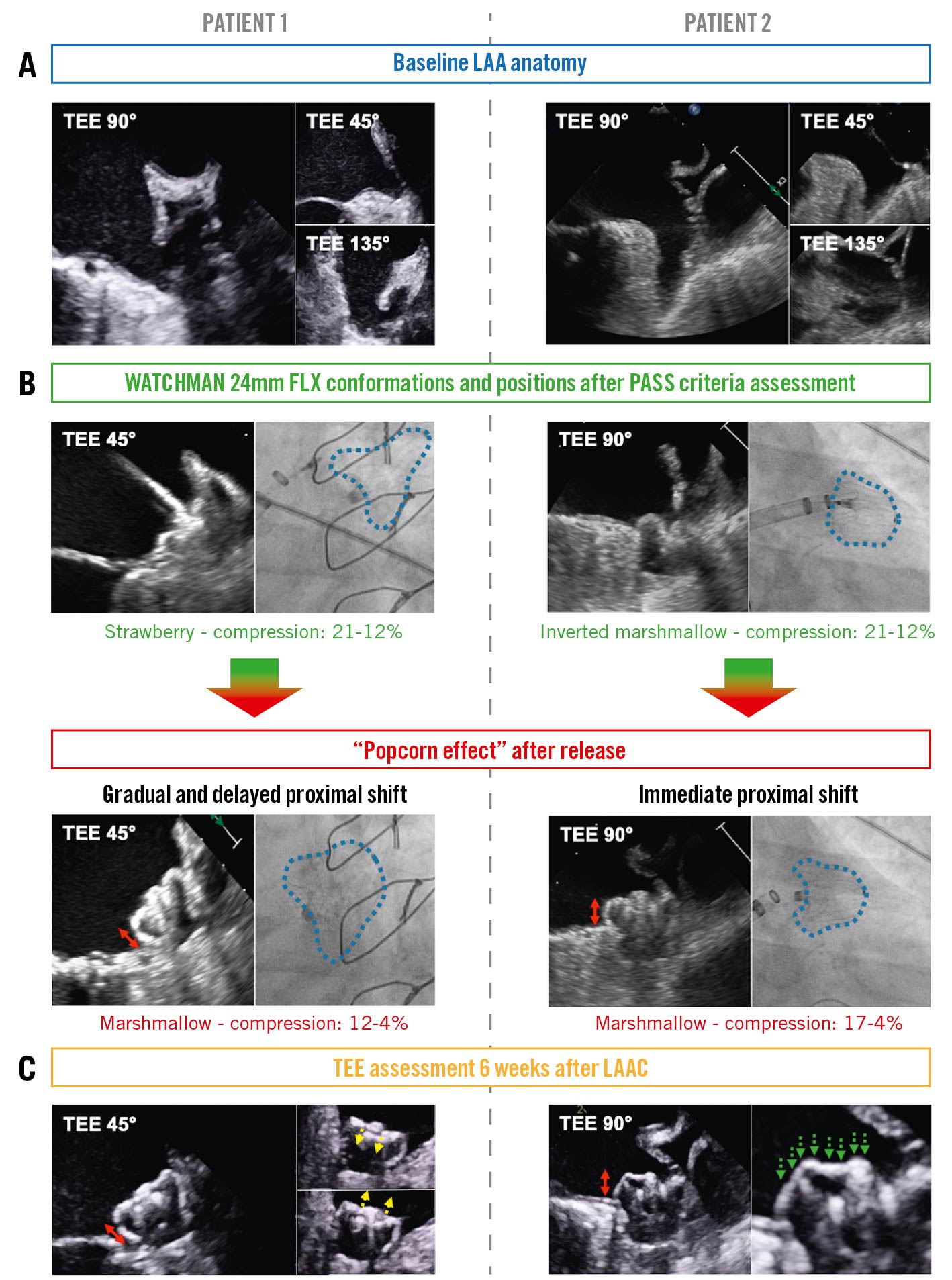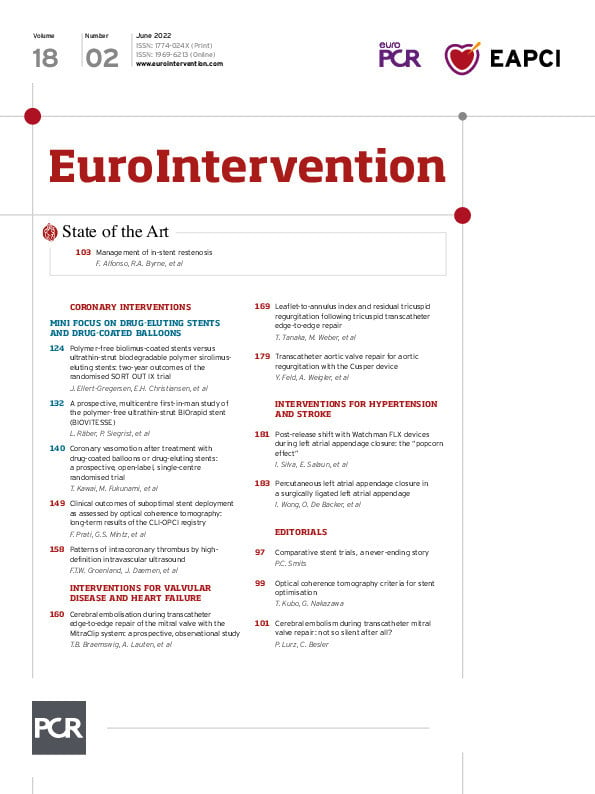
Figure 1. Procedural popcorn effect and atypical images of the polyester fabric cover during the follow-up with the Watchman FLX devices. A. Baseline LAA anatomy in patients 1 and 2. B. PASS criteria before release, and position, compression, and conformation after "popcorn effect" in patients 1 (delayed) and 2 (immediate) following the release. Prolonged TEE observation showed a stable position with shoulder (red double arrow) but without residual motion. C. At the 6-week TEE follow-up, presence of mild billowing motion of the polyester fabric cover (wind sailing effect) for patient 1 (yellow dashed arrows) and partially raised polyester cover fabric without motion for patient 2 (green dashed arrows). LAA: left atrial appendage; LAAC: left atrial appendage closure; TEE: transoesophageal echocardiogram
The Watchman FLX (Boston Scientific) is the new-generation device for left atrial appendage (LAA) closure which is gradually replacing the Watchman 2.51. In this transition period, pertinent reports and technical issues related to the currently commercialised Watchman FLX should be reported in order to increase the experience of operators and LAAC teams. We report 2 cases of post-release morphological change and proximal position shift of the Watchman FLX device despite having achieved the “Position, Anchor, Size and Seal” (PASS) criteria before release. This proximal shift of the device after release, gradual and delayed for patient 1 and immediate for patient 2, was named the “popcorn effect” (Figure 1).
In patient 1, a 24 mm Watchman FLX device was inserted in a LAA with classical chicken wing morphology. The device was released in a strawberry conformation once all PASS criteria were met, including a stable position after a standard tug test (Moving image 1). The immediate post-release position remained stable (Moving image 2). However, a few minutes later, a gradual device shift and a progressive “popcorn effect”, including changes in conformation (marshmallow), compression and position, was observed.
In patient 2, a 24 mm Watchman FLX device was inserted in an LAA with inverted chicken wing morphology. Before release, the device had an inverted marshmallow conformation with a stable position after a standard tug test (Moving image 3), and PASS criteria were met. Nevertheless, a sudden “popcorn effect” was seen immediately after release with changes in conformation (marshmallow), compression, and position (Moving image 4).
In both cases, prolonged intraprocedural echocardiographic surveillance and transoesophageal echocardiographic (TEE) control at 6-week follow-up demonstrated a stable final position and no residual significant motion of the devices. However, atypical images of the polyester fabric cover were present for both patients at 6 weeks: i) a mild billowing motion with a “wind sailing effect” for patient 1 (Moving image 5), as previously reported in another case2; and ii) a partially raised polyester fabric cover without motion for patient 2 (Moving image 6).
Immediate or delayed “popcorn effect” may be related to a variety of facts. First, the storage of tension within the delivery system may lead to a drastic change in conformation after release, despite a stable position during the tug test and the validation of PASS criteria before release. Second, in challenging anatomical settings, the radial forces of the Watchman FLX device may not be uniformly distributed upon initial expansion. This may cause a “champagne cork” motion of the device after release, regardless of the position and the approach of the delivery system prior to release. The occurrence of the “popcorn effect”, as a particular phenomenon of the FLX generation, remains troubling and could result in improper positioning or even device embolisation, which often results in open cardiac surgery for device removal. More attention should be paid to this effect observed with the Watchman FLX, and data should be reported if encountered with other types of devices.
The association of the “popcorn effect” with atypical images of the polyester fabric cover seen during the echocardiographic follow-up remains unclear, as does the impact of fabric cover abnormalities on prosthesis. A suboptimal and proximal position of the device, related to the “popcorn effect”, leads to more exposed prosthetic material in the left atrium. This could result in a higher risk of device-related thrombosis (and thus ischaemic stroke), especially if associated with a delay in the endothelisation of the device related to the fabric cover abnormality.
Funding
I. Silva is supported by a grant from the Martin Escudero Foundation (Madrid, Spain).
Conflict of interest statement
The authors have no conflicts of interest to declare.
Supplementary data
To read the full content of this article, please download the PDF.
Moving image 1. Fluoroscopy showing stable tug test and a strawberry conformation of the Watchman FLX device.
Moving image 2. Fluoroscopy showing immediate post-release position of the Watchman FLX device.
Moving image 3. Fluoroscopy showing stable tug test and inverted marshmallow conformation.
Moving image 4. Fluoroscopy showing the “popcorn effect” with immediate changes in conformation, compression, and position of the Watchman FLX device after release.
Moving image 5. Transoesophageal view showing mild billowing motion with a “wind sailing effect” of the Watchman FLX device.
Moving image 6. Transoesophageal view showing partially raised polyester cover fabric without motion of the Watchman FLX device.

